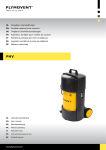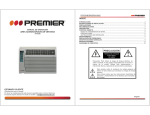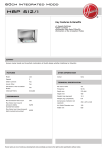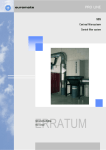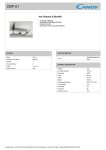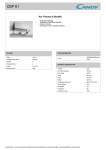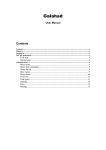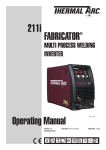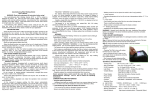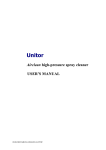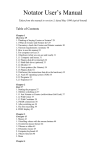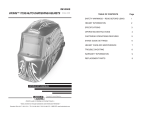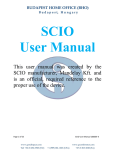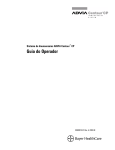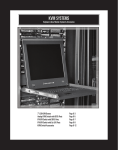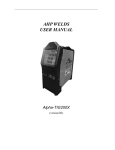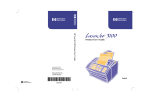Download FumeClean 230
Transcript
FumeClean 230 Portable high vacuum welding fume extractor Product no 196-735878 Instructions for use CONTENTS: Page 1 IDENTIFICATION OF THE PRODUCT 2 2 SAFETY INSTRUCTIONS AND WARNINGS 3 3 USED PRODUCTS AND THE ENVIRONMENT 4 4 TECHNICAL SPECIFICATIONS 5 5 GENERAL DESCRIPTION 7 6 INSTALLATION 8 7 USE 9 8 MAINTENANCE 11 9 TROUBLESHOOTING 13 10 ORDERING AND SPARE PARTS 14 1 1 IDENTIFICATION OF THE PRODUCT The identification plate (see fig. 1) contains the following data: A serial number B product name C max. power (speed setting ‘high’) D supply voltage and frequency 2 2 SAFETY INSTRUCTIONS AND WARNINGS General The manufacturer does not accept any liability for damage to the product or personal injury caused by nonobservance of the safety instructions in this manual, or by negligence during installation, use, maintenance and repair of the product mentioned on the cover of this document and any corresponding accessories. Specific working conditions or used accessories may require additional safety instructions. Immediately contact your supplier if you detect a potential danger when using the product. The user of the product is always fully responsible for observing the local safety instructions and regulations. Observe all applicable safety instructions and regulations. User manual • Everyone working on or with the product must be familiar with the contents of this manual and must strictly observe the instructions therein. Management should instruct their personnel in accordance with the manual and they must observe all instructions and directions given. • Never change the order of the steps to perform. • Always keep the manual with the product. Intended use 1) The product has been designed exclusively for extracting harmful fumes and gases that are released during the most common light and medium welding processes. Using the product for other purposes is considered contrary to its intended use. The manufacturer accepts no liability for any damage or injury resulting from such use. The product has been built in accordance with state-of-the-art standards and recognized safety regulations. Only use the product in technically perfect condition in accordance with its intended use and the instructions laid down in the user manual. 1) "Intended use" as laid down in EN-292-1 is the use for which the technical product is suited as specified by the manufacturer, inclusive of his directions in the sales brochure. In case of doubt it is the use which can be deducted from the construction, the model and the function of the technical product which is considered normal use. Operating the machine within the limits of its intended use also involves observing the instructions in the user manual. WARNING Fire hazard! Never use the product for extracting inflammable, glowing or burning particles or solids or liquids. Never use the product for extracting aggressive fumes (such as hydrochloric acid). The product may be used for extracting and/or filtering fumes and gases that are released during the following welding processes: • MIG/MAG solid wire (GMAW) • MIG/MAG flux cored wire (FCAW) • Stick welding (MMA or SMAW) • TIG (GTAW) welding Welding class “W3”: The product is suitable for the extraction of fume from metals that have a nickel and chrome (for example) content over 30%. Never use the product for extracting and/or filtering fumes and gases which are released during the following (welding) processes: • MIG/MAG welding robots with intensive use of TipDip or other anti-spatter products • autogenic or plasma cutting • arc-air gouging • (welding with) a release of a dense oil mist • paint spraying • extraction of hot gases (more than 40°C continuously) • extraction of aggressive fumes (such as acids) 3 • grinding aluminium and magnesium • thermal spraying (i.e. plasma etc.) • extraction of cement, saw dust, wood dust, etc. • sucking cigarettes, cigars, tissues and other burning particles, objects and acids • any dangerous situations in which there is a risk of an explosion or fire WARNING Never reach into the intake or outlet of the fan. Modifications Modification of the product or any of its parts is not allowed. 3 USED PRODUCTS AND THE ENVIRONMENT PACKAGING MATERIAL The purpose of the packaging is to protect the product during transport. It consists of the following substances which can be reused: - polyethylene foil - corrugated cardboard Do not dispose of the packaging material as industrial waste, but ask your municipal sanitation department where to dispose of the material. 4 4 TECHNICAL SPECIFICATIONS 4.1 General Net weight 16 kg Extraction volume (clean filter with 2,5 m hose and EN 20): • speed setting ‘low’ • speed setting ‘high’ Filter surface main filter Filter surface HEPA filter Filter efficiency 140 m3/h 230m3/h 12 m2 0,4 m2 99,9% (incl.HEPA filter H12) 4.2 Dimensions 5 4.3 Electric system See the identification plate (fig 1) and the separate electrical diagram. Power consumption: • speed setting ‘low’: ±70% • speed setting ‘high’: 100% 4.4 Ambient conditions 5°C 40°C 80 % 50 Min. operating temperature Max. operating temperature Max. relative humidity IP class 4.5 Sound pressure The level of the A-weighed sound pressure is 70 dB(A) according to ISO 3746. Measurements performed in the workshop with a PHV fitted with a welding torch. 6 5 GENERAL DESCRIPTION The machine consists of the following main components (see fig. 3) A control panel B fans C mains cord D air intake Ø 48 mm E bottom F pre-separator G wheels H integrated prefilter I main filter Dura-H J outlet cover K HEPA filter L top cover 5.1 General description The machine has been specially designed for extracting and/or filtering harmful fumes and gases that are released during the most common light and medium welding processes. With its the wheels, the handle and its compact design the machine is extremely suited to be used in relatively small workshops or near sources of pollution without a fixed location. 5.2 Operation The machine works in accordance with the re-circulation principle. The extracted fumes pass the air intake and enter the pre-separator in which primary filtration takes place and where sparks, if any, are separated. Subsequently the air passes the pre-filter and the main filter, in which most of the fume particles are filtered out. Finally, the fan blows the air into the HEPA filter where the remaining fumes are separated. The cleaned air is returned into the workshop via the outlet grid. With the optional hose connection HCH 45 the air can be discharged elsewhere, for example into the atmosphere, such as is the case when welding stainless steel. The welding fumes can be extracted at source in the following ways: A by the supplied extraction hose Ø 45 mm connected to the welding torch B by the supplied extraction hose Ø 45 mm connected to the extraction nozzle 7 6 INSTALLATION 6.1 Unpacking Check that the machine is complete. The package should contain: • portable welding fume extractor • extraction hose 2,5 m/Ø 45 mm • 4 carbon brushes • user manual • electrical diagram 6.2 Installation The machine is ready for use. CAUTION! Do not position the machine in places where it is exposed to vibrations or radiation from heat sources. Observe the ambient conditions as described in chapter 4.4. 6.3 Connection to the mains CAUTION! Make certain that the machine can be connected to the local mains. Specifications with respect to supply voltage and frequency can be found on the identification plate. 8 7 USE CAUTION! Before use carefully read the safety regulations. WARNING It is required that the product is in an upright position and that the inlet is closed when transporting the product over larger distances. 7.1 Controls . The required under-pressure will not be achieved in the 'low' mode of operation. As a consequence, the warning signal will not be activated. 9 The control panel (see fig. 4) contains the following controls: A Button: on/off; low/high Button for switching the machine on and off and for switching from ‘low’ to ‘high’ motor speed and vice versa. B Button manual/auto Button for switching the machine from automatic on/off to manual control and vice versa. C Button: reset (optionally) Button to reset the filter pollution indicator. D Slit mass cable; automatic start/stop Slit for inserting the mass cable of the welding machine; this activates the arc sensor for automatic on/off switching of the extractor. Min. current 50 Amps. E On/off switch (USA/Canada) Switch for switching the machine on and. When this switch is installed, button A's on/off function becomes obsolete. 7.2 Use 7.2.1 PHV with welding torch + integrated extraction Before use, carefully read the user manual of the welding torch. • Connect the extraction hose Ø 45 mm at one side to the air intake of the machine and at the other side to the welding torch. • Put the mass cable of the welding machine into the slit on top of the machine. • Start up the machine by pressing the on/off button. Preferably use the automatic start/stop device (‘auto’) to extend the life of the carbon brushes. • The machine continues to run for 15 seconds (in the 'auto' setting) after welding is completed. 7.2.2 PHV with extraction nozzle The machine can be supplied with two types of extraction nozzles: - funnel nozzle with magnetic foot (EN 20) for various welding processes/situations; - slit extraction nozzle with magnetic foot (EN 40) for horizontal welding activities, such as stick welding. It is recommended that the extraction nozzle EN 20 is positioned above the welding spot (when possible) to achieve optimum welding fume extraction. • Place the extraction nozzle at 2-4 cm from the source of pollution. • Insert the mass cable of the welding machine into the slit on top of the extractor. • Start up the machine by pressing the on/off button. Preferably use the automatic start/stop device (‘auto’) to extend the life of the carbon brushes. • The machine continues to run for 15 seconds (in the 'auto' setting) after welding is completed. . When using the machine, regularly check that the extraction capacity is sufficient. When the extraction capacity decreases, the filters should be replaced. Decrease of extraction capacity may lead to a too high concentration of harmful welding fumes in the workshop. When the machine is provided with a filter pollution indicator (option), there will be acoustic and optical signals when the extraction capacity is too low. 10 8 MAINTENANCE The machine has been designed to function without problems for a long time with a minimum of maintenance. In order to guarantee this some simple, regular maintenance and cleaning activities are required which are described in this chapter. If you observe the necessary caution and carry out the maintenance at regular intervals, any problems occurring will be detected and corrected before they lead to a total standstill of the machine. The indicated maintenance intervals can vary depending on the specific working and ambient conditions. Therefore it is recommended to thoroughly inspect the complete machine once every year in addition to the indicated periodic maintenance. Please contact your supplier for this inspection. PHV-I only; Germany-specific: Inspection and maintenance in accordance with TRGS 560 (W2 and W3): Inspection and maintenance of the product shall be carried out in conformance with TRGS 560, chapter 5, paragraph 9. WARNING! Overdue maintenance may cause a fire. WARNING! Always switch the machine OFF and remove the mains plug from the wall socket before carrying out the activities below. First read the maintenance regulations at the beginning of this manual. 8.1 Periodic maintenance The maintenance activities in the table below indicated by [1] can be carried out by the user; other activities shall only be carried out by qualified personnel. 8.2 Replacing the filters The main filter and the HEPA filter cannot be cleaned and therefore they have to be replaced periodically. WARNING! A saturated filter often contains dust and dirt particles which could form a health hazard upon inhalation. When replacing the filters always wear a high-quality and approved face mask. Wrap the filters in a properly closed plastic bag and dispose of it in compliance with the local regulations. It is not allowed to empty the filters using air or by tapping. Replace the filters in case of damage or when the extraction capacity has become insufficient due to the amount of pollution materials in the filter. One must learn from experience when to replace the filters, since the life of the filters strongly depends on the composition of the welding fumes, the humidity, etc. Proceed as follows (see fig. 5): 11 8.2.1 Replacement of the main filter Use the plastic bag that contains the new filter to exchange the filter for a new one. Draw the bag carefully over the old filter when removing the filter. After that close the bag with a tie wrap. The pre-separator can also be emptied in the same bag. • Loosen the side clips (A). • Remove the top cover (B) from the machine. • Carefully remove the main filter (C) from the bottom of the machine. • Check the seals before placing a new filter. If the seals need to be replaced, contact your supplier. • Place the new filter and mount the disassembled parts in reverse order. Check that the integrated aluminium pre-filter is placed at the bottom. 8.2.2 Replacement of the HEPA filter • Remove the outlet cover by loosening the two screws (D) • Remove the HEPA filter (E). • Place a new HEPA filter in the correct position (open side at the top); to facilitate this, apply some suds to the seals. • Remount the outlet cover by fastening the two screws. Make sure that the outlet cover is in the right position; the open side of the HEPA filter should correspond with the smallest opening of the outlet cover. ATTENTION: By taking out the HEPA filter, its seals will deform. For this reason, never replace a used HEPA filter, but always place a new one. 12 9 TROUBLESHOOTING If the machine does not function (correctly), please consult the checklist below to see if you may remedy the error yourself. If not, please contact your supplier. WARNING! Always switch OFF the machine and remove the mains plug from the wall socket before carrying out any repairs. The repair activities in the table below indicated by [1] can be carried out by the user; other activities shall only be carried out by qualified personnel. Always replace all motor seals when replacing or carrying out maintenance on the motors. If the supply cord is damaged, it must be replaced by the manufacturer or its service agents or a similarily qualified person in order to avoid hazard. Problem Motor does not start. Extraction capacity insufficient. Motor stops automatically. Possible cause No mains voltage. Supply cord defective. Carbon brushes worn. Motor defective. Main filter polluted. Solution Check the mains voltage. Repair or replace the supply cord. Replace the carbon brushes. Replace both motors. Replace both main filter and HEPA filter [1]. Extraction hose damaged or leak. Replace the extraction hose [1]. Seals damaged or leaking. Replace the seals. Thermal protection is activated. Check that the cooling slits underneath the top cover and/or the outlet are not obstructed. Dust or smoke coming Filter torn or placed incorrectly. out of the outlet grid. 13 Replace the filter or position it correctly [1]. 10 ORDERING AND SPARE PARTS FumeClean 230 Product number 196 735878 Delivered complete with 2,5m hose and nozzle with magnet foot Optionals Bulkhead bracket Hose connection, outlet side Active carbon filter 196 740399 196 740381 196 740431 Spares Disposable Cartridge Filter High Efficiency Particle Filter H12 Funnel Nozzle With Magnetic Foot Extract/Exhaust Hose 2,5 M, Ø 45mm Connection Piece For Two Hoses Ø 45mm Carbon Brushes 2 Sets W.Seals 230V 196 740415 196 740423 196 740373 196 740449 196 740456 196 740407 14 Unitor ASA Mail: P.O. Box 300 Skøyen, N-0213 Oslo, Norway. Office: Drammensvn. 175, N-0277 Oslo, Norway. Tel: +47 22 13 14 15, Fax: +47 22 13 45 00 Tlx: 76004 UNITOR N www.unitor.com 15
















